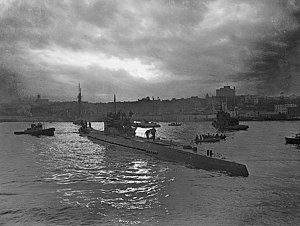
Back Schlacht am Sankt-Lorenz-Strom German Batalla del Golfo San Lorenzo Spanish Bataille du Saint-Laurent French Battaglia del San Lorenzo Italian Batalha de Sant Laurenç Occitan Битва в заливе Святого Лаврентия Russian Бої в затоці Святого Лаврентія Ukrainian
| Battle of the St. Lawrence | |||||||
|---|---|---|---|---|---|---|---|
| Part of the Battle of the Atlantic | |||||||
 German submarine U-190 arrives in St. John's, Newfoundland in June 1945 after surrendering | |||||||
| |||||||
| Belligerents | |||||||
|
|
| ||||||
| Commanders and leaders | |||||||
|
|
| ||||||
| Strength | |||||||
|
| ||||||
| Casualties and losses | |||||||
|
23 merchant ships sunk 4 RCN ships sunk 340 killed | Some U-boats damaged and some crewmen killed,[2] All spies captured | ||||||
The Battle of the St. Lawrence involved marine and anti-submarine actions throughout the lower St. Lawrence River and the entire Gulf of Saint Lawrence, Strait of Belle Isle, Anticosti Island and Cabot Strait from May–October 1942, September 1943, and again in October–November 1944. During this time, German U-boats sank over 20 merchant ships and four Canadian warships. There were several near-shore actions involving the drop of German spies, or the attempted pickup of escaping prisoners of war. Despite the 23 ships lost, this battle marked a strategic victory for Canadian forces as ultimately they managed to disrupt U-boat activity, protect Canadian and Allied convoys, and intercept all attempted shore operations. This marked the first time that a foreign power had inflicted casualties in Canadian inland waters since the US incursions in the War of 1812.[1]
In the interwar years, poor economic conditions and a sense of security, engendered by the proximity of the United States and the traditional protection of the Royal Navy, had resulted in the Royal Canadian Navy (RCN) being equipped with very few ships, especially for coastal defence.[3] Upgraded to six destroyers just before the war, Canadian naval deployment gave priority to the North Atlantic convoy routes. By the end of the war, the RCN had expanded to become the third largest allied naval power, with 400 vessels and 100,000 men and women.[4] The Royal Navy contributed two destroyers to the fight in October 1942 when attacks reached their peak.
- ^ a b The battle of the Gulf of St. Lawrence. Veterans Affairs Canada. 2005. ISBN 0-662-69036-2.
- ^ Granatstein & Oliver (2011), p. 32.
- ^ Jackson, Ashley (2006). The British Empire and the Second World War. London: Hambledon Continuum. p. 64. ISBN 1-85285-417-0.
- ^ Mosseray, Fabrice (1995–2007). "The Battle of the St. Lawrence". uboat.net. Guðmundur Helgason. Retrieved 14 November 2007.
© MMXXIII Rich X Search. We shall prevail. All rights reserved. Rich X Search